Initial designs, locations for two big builds at UniSA’s City West campus worth $500 million
UniSA is pushing ahead with its $500m plan to radically change the skyline and bring thousands more students to the West End, as Adelaide and Flinders reveal their big construction plans.
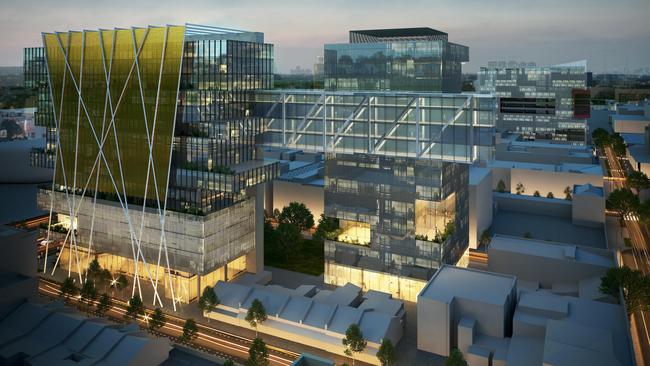
Tertiary
Don't miss out on the headlines from Tertiary. Followed categories will be added to My News.
- How SA could become a global, post-COVID education hub
- How to get the most out of your Advertiser digital subscription
UniSA is forging ahead with its transformation of the city’s West End, unveiling plans for two landmark buildings and other projects costing more than $500 million.
The Sunday Mail can reveal initial designs for significant projects on both Hindley St and North Tce.
They will allow the uni to consolidate firstly its Magill, then City East campuses, onto the City West campus, bringing 15,000 more students to the West End.
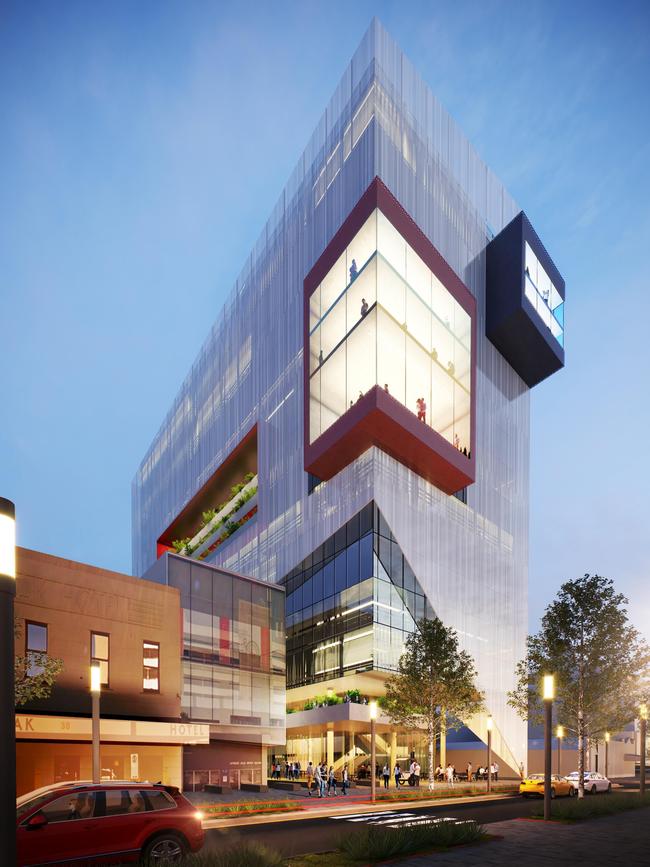
The Hindley St project, on the site of the uni’s Heysen building and the former Barbecue Inn, will house its creative industries courses as well psychology, social work and law.
The ground floor will bring together the uni’s range of public clinics including health, law, psychology, social work and tax.
Vice-chancellor David Lloyd says that ideally, if the post-COVID recovery allows for a return to “some sense of normality and certainty” of revenue streams, construction will begin in 2022 for an opening in 2024.
The uni can cover the cost from its own reserves.
The second building will be on the corner of North Tce and Gray St, where the uni’s public health clinic now sits. It will be for health sciences, physiotherapy, nursing and midwifery students currently at City East.
Financing for that is trickier, as it will require the sale of City East buildings, officially valued at $113.4 million, and some borrowing, but the aim is to start in 2024 and open in 2026.
Prof Lloyd said the buildings will be similar in scale to the uni’s14-level Cancer Research Institute (CRI) on North Tce, next to the Morphett St Bridge.
“When I look at the city, the East End has changed significantly. The West End hasn’t that much, apart from the biomed (precinct),” he said.
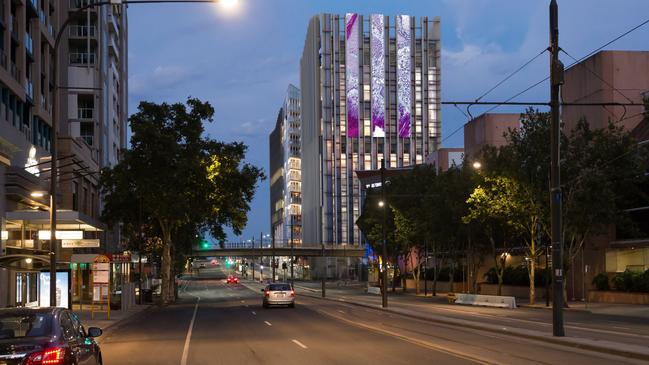
“We’ve been low-rise here, but there’s no impediment to going high. I don’t want to build some monolithic big towers. They’ll be two decent, functional buildings with multipurpose activities going on in them, (with) public domain on the ground floor.”
He said the projects would “shift again the way in which the city works”.
“Our population will get significantly bigger here. If we get the concentration of students right here, you’ll end up with a really vibrant hub here in the West End.”
Prof Lloyd said the best-case timeline for the bigger projects is reliant on post-COVID recovery.
“It would be rash of me to spend down the capital reserve right now, when I don’t know what next year is going to look like in terms of making sure that we can keep all of our staff employed.”
But there are plenty of job-creating smaller projects in the meantime. Mid next year, three giant LED screens, each spanning up to five-storeys and collectively costing $3m, will be integrated into the eastern facade of the CRI and showcase UniSA’s MOD (Museum of Discovery).
“They’ll be the biggest billboard in Adelaide,” Prof Lloyd said.
He expects a major refit of the former Night Train building on Light Square to become UniSA’s “enterprise hub” to happen next year.
It will be the uni’s “front door” for industry to engage with its researchers, as well as housing an incubator for start-ups and “scale-ups”, plus business consultancy services.

MORE NEWS
SA unis claw way out of red hole
SA school principals frustrated over dud teachers, NAPLAN
Biggest uni fee shake-up in a decade
Also next year, the uni will a build a research lab at an undisclosed location, accredited under the federal Defence Industry Security Program.
“That’s about a $2 million investment that allows us to do classified research within the networks of government, which is a really key piece for the defence industry here in South Australia,” Prof Lloyd said.
Other plans include turning the courtyard of the current law building at City West into an indigenous centre including a “yarning circle”.
A long-awaited upgrade of George St, which runs through the campus, remains subject to negotiations with Adelaide City Council. The uni is prepared to invest $5 million if the council agrees to a permanent closure.
The plan for the Magill campus, as revealed by The Advertiser in 2018, remains a privately-funded retirement and aged care centre which would be a key site for placements of UniSA’s health and aged care students.
Flinders Village on the right track
Plans for a $250 million health and medical research building are being pitched to government as the key to unlocking private investment for the $1.5 billion Flinders Village development.
Flinders University vice-chancellor Colin Stirling said the uni was “literally on the brink of signing a contract to begin building” when the COVID-19 pandemic struck.
“Then all this uncertainty hit, so we have put it on hold,” he said.
“If we can secure funds to restart … we can light that project up at the drop of a hat.”
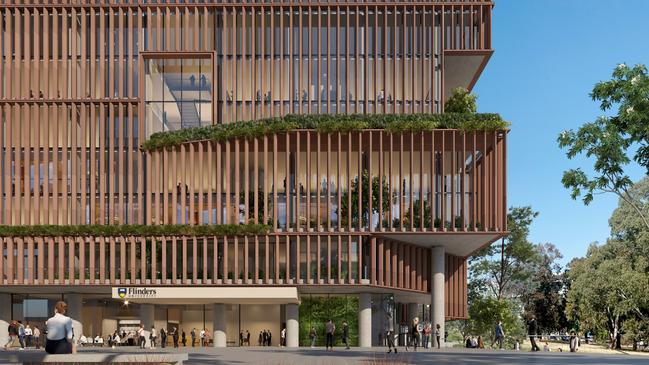
The university is lobbying the state and federal governments for loans or funds for the health building, which would be shovel-ready within weeks of securing finance.
Prof Stirling said such a large project would deliver a significant post-COVID stimulus for the local economy, providing jobs for countless tradies.
It was also vital to boosting numbers of health researchers and attracting the very best talent.
He said the uni would be happy with loans because “we’re big enough that even in these difficult times we are willing to take on a bit of debt”.
“We know that we have to pay our way,” he said.
“If we were able to trigger this (health) development, that would be the stimulus to begin those discussions again with potential developers (for other village projects).”
Pre-coronavirus, the uni was “making very rapid progress” towards the village’s first three buildings, the others being a second health building – to be largely privately funded and leased to the uni – and a student accommodation one.
Prof Stirling said uncertainty, particularly over international students, means “we’re going to be very prudent about what we spend”.
Updated concept images show how the village will spring up around the new train station at the end of the new Flinder Link rail extension, in the lower part of the Bedford Park campus.

The first trains are expected to arrive in time for the start of first semester next year.
To start with, the uni is working on a “pop-up community plaza” with “food trucks, shady plants and seating” to welcome commuters.
Eventually the village will house 3000 student beds across a dozen or more buildings.
Its heart will be known as Flinders Square, surrounded by the station, research buildings, a boutique shopping centre and hotel.
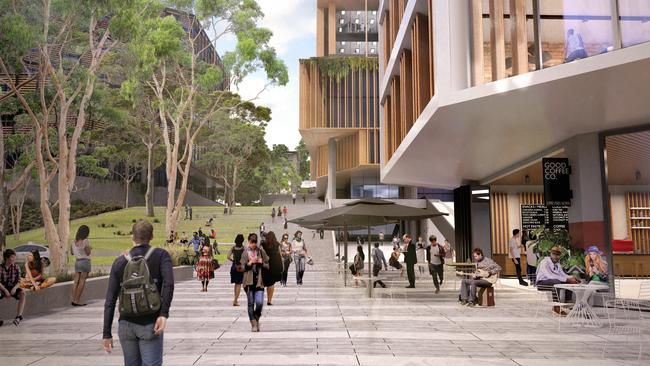
Last year, the uni said it would sustain 1000 construction jobs for a decade.
Prof Stirling said even without embarking on big new building, Flinders usually spent around $50 million a year on various job-creating capital works, such as its new augmented reality centre, but it was having to pause $15 million worth this year.
State Treasurer Rob Lucas said he would wait for a formal proposal to consider, but noted taxpayers could not “support every funding submission that we receive”.
Federal Education Minister Dan Tehan said unis should approach banks, which the Government had worked with “to provide liquidity to the market”.
Adelaide Uni’s cyber power tower
By Chris Russell
A NEW centre at Lot Fourteen creating hundreds of jobs for world-leading scientists in the increasingly important area of protecting information is planned by Adelaide University.
Business and government agencies back the plan which would deliver a big boost to the South Australian economy, the university said.
It would include constructing a new tower building on the prestigious North Tce site.
“Society is now more digital than ever, and our dependence on the virtual is growing in all sectors,” said Anton Middelberg, deputy vice-chancellor in charge of research.
“Developing appropriate ‘information capability’ to master this new future will be the next great security challenge for Australian society.”
The university now has some 180 people in different but related areas — such as computer science, physics, machine learning, robotics and mathematics — who would become attached to the new venture.
“We’d probably also get some IT systems people from the business school and some psychologists and social scientists,” he said.
“So we would draw from across the university for that initial core and then new ongoing jobs would be between 300 and 400 scientists.”
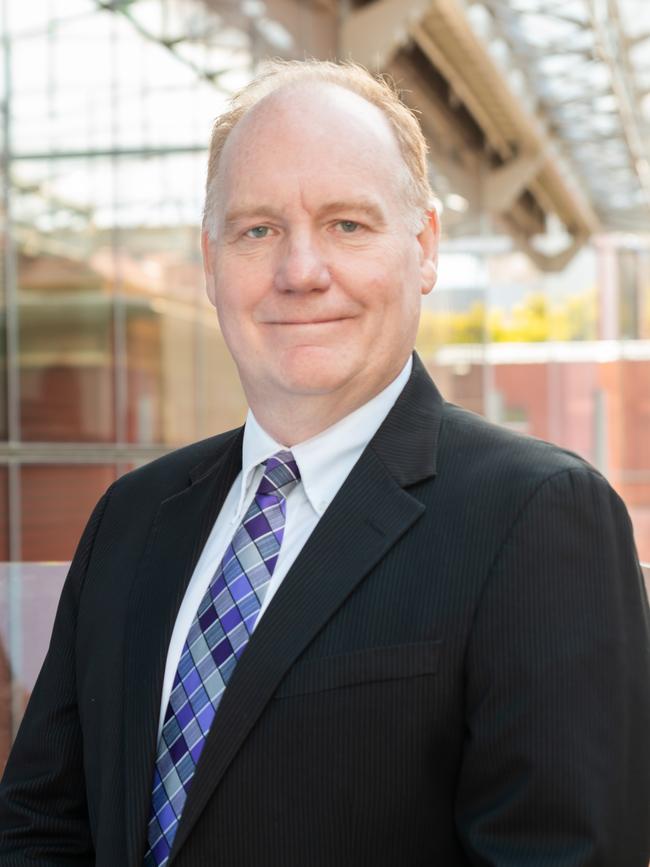
In addition, work on the building — preliminarily estimated at around $150 million — would support hundreds of construction jobs.
Independent economic modelling estimates the new centre would have a $460 million economic impact over 30 years.
Professor Middelberg said this was a very conservative figure and did not include money to be made from creating spin-off companies in what was a sector enjoying rapid growth.
“It’s almost a guaranteed uplift in economic activity,” he said.
“The beauty of this is that it’s not something a bunch of academics have dreamt up — it’s come out of our industry advisory boards.”
The boards, with senior figures from major companies such as BAE, Boeing, Lockheed Martin, SAAB and government agencies, were challenged by the university for ways “to shift the dial” and create something internationally competitive.
“This is what the industry is calling for,” he said.
Several big companies had provided formal letters of support.
“Now we’ll start the conversations about building a consortium,” he said.
A State Government spokesman said Adelaide University already had a significant presence on Lot Fourteen.
“Universities feature prominently in our plans for Lot Fourteen, and the State Government has an excellent working relationship with all the universities,” he said.
The university runs the Australian Institute for Machine Learning, on the corner of North Tce and Frome Rd, which was already full and may take some floorspace in the new building, Professor Middelberg said.
“They’re in such high demand – being number three in the world for robot vision machine learning will do that,” he said.
It is involved in the Australian Space Agency, the Cyber Collaboration Centre and the planned Innovation Hub.
It is a founding partner in the Living Lab which was formed with the Massachusetts Institute of Technology, BankSA, Optus, DSpark and the State Government.
“It is exciting to see all the parts of SA — the government, banks, telcos, universities, medical, etc. — co-operating and committed to make innovation and jobs development a success,” MIT Professor Alex “Sandy” Pentland told the Sunday Mail.
“We are very happy that we are finding that we can help by providing technology and insights from other parts of the world, and have been able to help in bringing new companies and jobs to the area.”
BankSA chief executive Nick Reade said the Living Lab had performed well since founded a year ago.
“The work of the Living Lab is progressing well on three key research areas of transport planning, tourism, and jobs and future employment,” Mr Reade said.
Adelaide University also has a $100 million vision for its Waite campus involving three new builds – an agricultural technology research hub, a collaboration centre for working with industry and government agencies, and a new research and teaching winery.
However, the projects would require government funding.
“The market failure is at the infrastructure level,” Prof Middelberg said.
“Once the infrastructure is there it opens up a huge amount of activity.”

